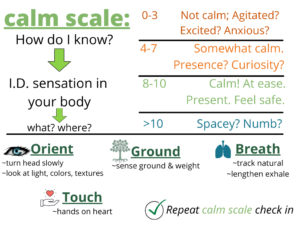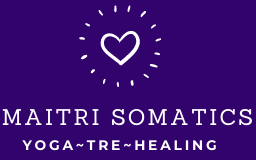This is a tool to assist you in learning how to read and influence your own nervous system for enhanced health and well being. You can not make yourself relax! Relaxing is a side effect of Resourcing. Learn which tools bring you more calm and support your sense of safety.
RESOURCING.
Check in on the calm scale. Try a resourcing strategy below. Re-check your level of calm on the scale below.

Calm Scale:
0-3 Not calm. (agitation? excitement? anxiety?)
4-7 Somewhat calm. (some presence? curiosity? sense ground?)
8-10 Calm! At ease, present, warmth.
>10 Sleepy? spacey? numb? not sure how you are feeling?
Resourcing strategies
Orienting: With eyes open, very slowly turn your head to one side, then the other, sweeping your gaze around your surroundings, taking in colors and textures. Be sure to look over each shoulder and allow your spine and pelvis to move with you.
Grounding: Feel the parts of your body resting on the ground, your chair or props. This would be your pelvis and legs sitting on the floor; bottoms of your feet when standing; and if sitting in a chair, feel your back against the back of the chair, your bottom on the seat, your feet on the floor. Sitting with your back against a wall (or another regulated person) can be more supportive, or not. Notice what brings more ease to your being.
Note: If you can’t feel the ground under you, place your hand(s) on the floor and squeeze the floor with your fingers. Feel for solid ground under your hands. Notice the effect. If you are standing and can’t feel your feet, stomp your feet a few times, marching, and notice the vibration and sensation. Then try to sense standing again. Try standing with your back to the wall. Notice.
Breath: Your breath is the one autonomic nervous system function that you can consciously interrupt (you can’t decide when and how you digest your food, so far). The breath is your neural “brake,” your way to down regulate your nervous system, bringing more calm. A very handy tool.
Natural breath: Allow yourself to be breathed by your breath. Let go of controlling your breath, and observe how the breath breathes you. Watch your autonomic nervous system work its magic!
Longer exhalations: Begin to count the length of your inhalation. Then take that number and double it for the exhalation. If you inhaled for a 4 count, exhale for an 8 count. Continue in this way for several rounds of breath. Begin to notice the pause that occurs at the top of your inhale and the bottom of your exhale. Return to natural breath. Check in on the calm scale.
Note: for some, attention to our breath increases anxiety. If this is true for you, work with a different strategy for a while. Over time, you will be able to return to working with breath.
Remember: this post is for informational purposes only and may not be the best fit for you and your personal situation. It shall not be construed as medical advice. The information and education provided here is not intended or implied to supplement or replace professional medical treatment, advice, and/or diagnosis. Always check with your own physician or medical professional before trying or implementing any information read here.






